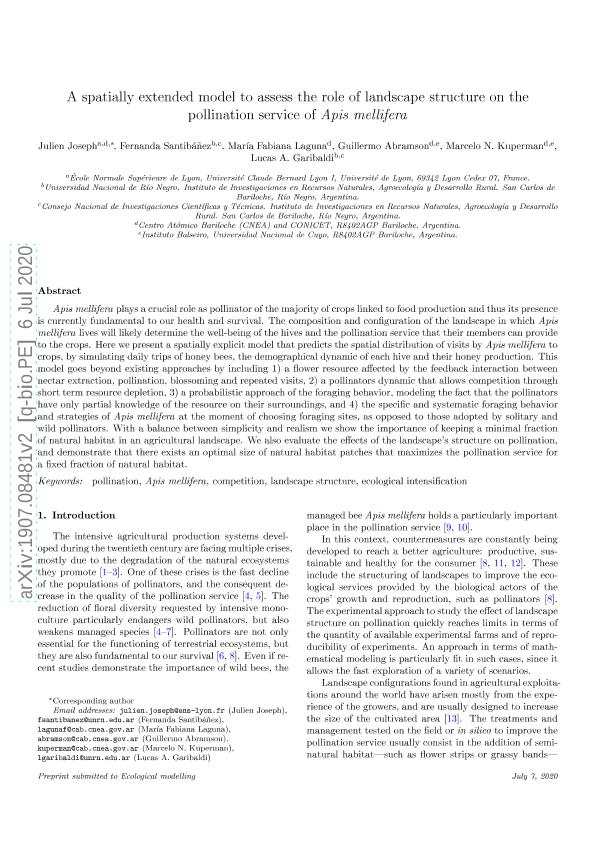Mostrar el registro sencillo del ítem
dc.contributor.author
Joseph, Julien
dc.contributor.author
Santibáñez, Fernanda
dc.contributor.author
Laguna, Maria Fabiana

dc.contributor.author
Abramson, Guillermo

dc.contributor.author
Kuperman, Marcelo Nestor

dc.contributor.author
Garibaldi, Lucas Alejandro

dc.date.available
2020-09-29T21:45:42Z
dc.date.issued
2020-09
dc.identifier.citation
Joseph, Julien; Santibáñez, Fernanda; Laguna, Maria Fabiana; Abramson, Guillermo; Kuperman, Marcelo Nestor; et al.; A spatially extended model to assess the role of landscape structure on the pollination service of Apis mellifera; Elsevier Science; Ecological Modelling; 431; 9-2020; 1-9; 109201
dc.identifier.issn
0304-3800
dc.identifier.uri
http://hdl.handle.net/11336/115131
dc.description.abstract
Apis mellifera plays a crucial role as pollinator of the majority of crops linked to food production and thus its presence is currently fundamental to our health and survival. The composition and configuration of the landscape in which Apis mellifera lives will likely determine the well-being of the hives and the pollination service that their members can provide to the crops. Here we present a spatially explicit model that predicts the spatial distribution of visits by Apis mellifera to crops, by simulating daily trips of honey bees, the demographical dynamic of each hive and their honey production. This model goes beyond existing approaches by including 1) a flower resource affected by the feedback interaction between nectar extraction, pollination, blossoming and repeated visits, 2) a pollinators dynamic that allows competition through short term resource depletion, 3) a probabilistic approach of the foraging behavior, modeling the fact that the pollinators have only partial knowledge of the resource on their surroundings, and 4) the specific and systematic foraging behavior and strategies of Apis mellifera at the moment of choosing foraging sites, as opposed to those adopted by solitary and wild pollinators. With a balance between simplicity and realism we show the importance of keeping a minimal fraction of natural habitat in an agricultural landscape. We also evaluate the effects of the landscape's structure on pollination, and demonstrate that there exists an optimal size of natural habitat patches that maximizes the pollination service for a fixed fraction of natural habitat.
dc.format
application/pdf
dc.language.iso
eng
dc.publisher
Elsevier Science

dc.rights
info:eu-repo/semantics/openAccess
dc.rights.uri
https://creativecommons.org/licenses/by-nc-sa/2.5/ar/
dc.subject
APIS MELLIFERA
dc.subject
COMPETITION
dc.subject
ECOLOGICAL INTENSIFICATION
dc.subject
LANDSCAPE STRUCTURE
dc.subject
POLLINATION
dc.subject.classification
Ecología

dc.subject.classification
Ciencias Biológicas

dc.subject.classification
CIENCIAS NATURALES Y EXACTAS

dc.title
A spatially extended model to assess the role of landscape structure on the pollination service of Apis mellifera
dc.type
info:eu-repo/semantics/article
dc.type
info:ar-repo/semantics/artículo
dc.type
info:eu-repo/semantics/publishedVersion
dc.date.updated
2020-09-25T19:06:14Z
dc.journal.volume
431
dc.journal.pagination
1-9; 109201
dc.journal.pais
Países Bajos

dc.journal.ciudad
Amsterdam
dc.description.fil
Fil: Joseph, Julien. Université Claude Bernard Lyon 1; Francia. Comisión Nacional de Energía Atómica. Centro Atómico Bariloche; Argentina
dc.description.fil
Fil: Santibáñez, Fernanda. Consejo Nacional de Investigaciones Científicas y Técnicas. Centro Científico Tecnológico Conicet - Patagonia Norte. Instituto de Investigaciones en Recursos Naturales, Agroecología y Desarrollo Rural - Universidad Nacional de Rio Negro. Instituto de Investigaciones en Recursos Naturales, Agroecología y Desarrollo Rural; Argentina
dc.description.fil
Fil: Laguna, Maria Fabiana. Consejo Nacional de Investigaciones Científicas y Técnicas. Centro Científico Tecnológico Conicet - Patagonia Norte; Argentina. Comisión Nacional de Energía Atómica. Centro Atómico Bariloche; Argentina
dc.description.fil
Fil: Abramson, Guillermo. Consejo Nacional de Investigaciones Científicas y Técnicas. Centro Científico Tecnológico Conicet - Patagonia Norte; Argentina. Comisión Nacional de Energía Atómica. Centro Atómico Bariloche; Argentina. Comisión Nacional de Energía Atómica. Gerencia del Área de Energía Nuclear. Instituto Balseiro; Argentina. Universidad Nacional de Cuyo; Argentina
dc.description.fil
Fil: Kuperman, Marcelo Nestor. Consejo Nacional de Investigaciones Científicas y Técnicas; Argentina. Comisión Nacional de Energía Atómica. Centro Atómico Bariloche; Argentina. Comisión Nacional de Energía Atómica. Gerencia del Área de Energía Nuclear. Instituto Balseiro; Argentina. Universidad Nacional de Cuyo; Argentina
dc.description.fil
Fil: Garibaldi, Lucas Alejandro. Consejo Nacional de Investigaciones Científicas y Técnicas. Centro Científico Tecnológico Conicet - Patagonia Norte. Instituto de Investigaciones en Recursos Naturales, Agroecología y Desarrollo Rural - Universidad Nacional de Rio Negro. Instituto de Investigaciones en Recursos Naturales, Agroecología y Desarrollo Rural; Argentina
dc.journal.title
Ecological Modelling

dc.relation.alternativeid
info:eu-repo/semantics/altIdentifier/url/https://www.sciencedirect.com/science/article/abs/pii/S0304380020302714
dc.relation.alternativeid
info:eu-repo/semantics/altIdentifier/doi/http://dx.doi.org/10.1016/j.ecolmodel.2020.109201
dc.relation.alternativeid
info:eu-repo/semantics/altIdentifier/url/https://arxiv.org/abs/1907.08481
Archivos asociados
